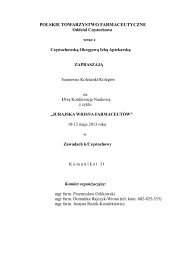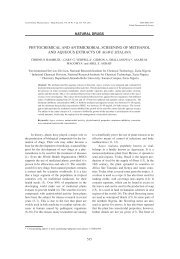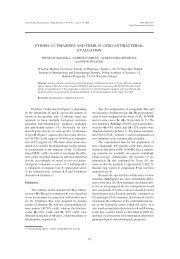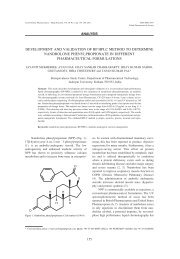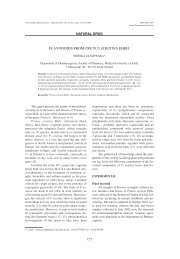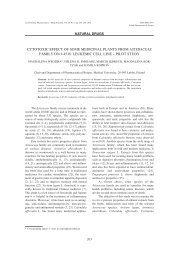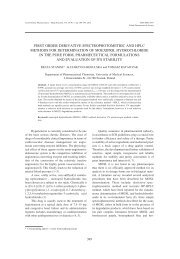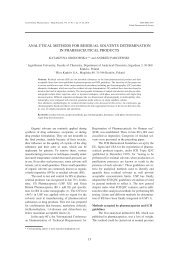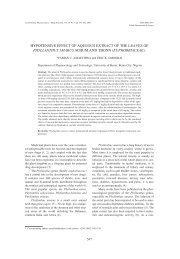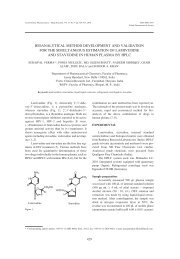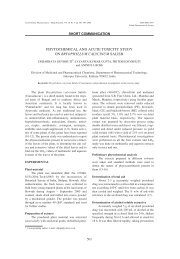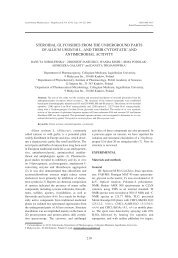cns activities of ethanol extract of aerial parts of hygrophila difformis ...
cns activities of ethanol extract of aerial parts of hygrophila difformis ...
cns activities of ethanol extract of aerial parts of hygrophila difformis ...
You also want an ePaper? Increase the reach of your titles
YUMPU automatically turns print PDFs into web optimized ePapers that Google loves.
Acta Poloniae Pharmaceutica ñ Drug Research, Vol. 68 No. 1 pp. 75ñ81, 2011 ISSN 0001-6837<br />
Polish Pharmaceutical Society<br />
CNS ACTIVITIES OF ETHANOL EXTRACT OF AERIAL PARTS<br />
OF HYGROPHILA DIFFORMIS IN MICE<br />
DILIPKUMAR PAL* and KRISHANU SAMANTA<br />
Seemanta Institute <strong>of</strong> Pharmaceutical Sciences, Jharpokharia, Mayurbhanj -757 086, Orissa, India<br />
Abstract: The <strong>ethanol</strong> <strong>extract</strong> <strong>of</strong> <strong>aerial</strong> <strong>parts</strong> <strong>of</strong> Hygrophila <strong>difformis</strong> (EEHD) was tested for possible pharmacological<br />
effects on experimental animals. EEHD significantly potentiated the sleeping time <strong>of</strong> mice induced<br />
by standard hypnotics, viz. pentobarbital sodium, diazepam, and meprobamate in a dose dependent manner.<br />
EEHD showed significant analgesic properties as evidenced by the significant reduction in the number <strong>of</strong><br />
writhes and stretches induced in mice by 1.2 % acetic acid solution. It also potentiated analgesia induced by<br />
morphine and pethidine in mice. Pretreatment with EEHD caused significant protection against strychnine and<br />
leptazol-induced convulsions. The behavioral studies on mice indicate CNS depressant activity <strong>of</strong> the <strong>ethanol</strong><br />
<strong>extract</strong> <strong>of</strong> H. <strong>difformis</strong>.<br />
Keywords: Hygrophila <strong>difformis</strong>, sleeping time, general behavior, analgesic activity, anticonvulsant activity<br />
Hygrophilla <strong>difformis</strong> Blume (commonly<br />
known as Water Wisteria, family: Acanthaceae ) is<br />
a tropical aquarium plants used as environmental<br />
ornaments. It is very fast growing plant that requires<br />
high light and nutrients to get good green growth. Its<br />
rapid growth helps prevention <strong>of</strong> algae. It grows to a<br />
height <strong>of</strong> 20ñ50 cm with a width <strong>of</strong> 15 to 25 cm. It<br />
has slender lacey leaves and upright growth. It is<br />
found in marshy habitats on the Indian subcontinent<br />
in Bangladsh, Bhutan, India and Nepal. The plant is<br />
used as anticoagulant by tribal people (1). It has also<br />
antioxidant properties (2). The <strong>aerial</strong> <strong>parts</strong> <strong>of</strong> H. <strong>difformis</strong><br />
on preliminary chemical analysis are found to<br />
contain hygrophiloside (3). The <strong>ethanol</strong> <strong>extract</strong> <strong>of</strong> H.<br />
<strong>difformis</strong> (EEHD) showed marked CNS depressant<br />
action compared to other <strong>extract</strong>s <strong>of</strong> it in preliminary<br />
pharmacological screening. However, no work has<br />
been reported on the CNS <strong>activities</strong> <strong>of</strong> this plant.<br />
Keeping this in view, the present study has been<br />
undertaken to investigate various CNS <strong>activities</strong><br />
such as behavioral, sedative-hypnotic, analgesic and<br />
anticonvulsant effects <strong>of</strong> EEHD in mice to substantiate<br />
the folklore claim.<br />
EXPERIMENTAL<br />
Preparation <strong>of</strong> <strong>extract</strong>s<br />
The <strong>aerial</strong> <strong>parts</strong> <strong>of</strong> H. <strong>difformis</strong> were collected<br />
from fields <strong>of</strong> Midnapur District, West Bengal in the<br />
month <strong>of</strong> December and were authenticated by Dr.<br />
M.S. Mondal, Additional Director, Central National<br />
Herbarium, Botanical Survey <strong>of</strong> India, Howrah and<br />
West Bengal. A voucher specimen has been preserved<br />
in our laboratory for future reference<br />
(DPKS1). Shade-dried, powdered, sieved (40 mesh<br />
size) plant materials were exhaustively <strong>extract</strong>ed<br />
successively with petroleum ether (40ñ60 O C), benzene,<br />
chlor<strong>of</strong>orm, <strong>ethanol</strong> and distilled water using a<br />
Soxhlet <strong>extract</strong>or. The <strong>extract</strong>s were concentrated to<br />
dryness in vacuum. The yield <strong>of</strong> <strong>ethanol</strong> <strong>extract</strong><br />
(EEHD) was 9.17% w/w.<br />
Chemical investigation <strong>of</strong> EEHD<br />
The <strong>ethanol</strong> <strong>extract</strong> was subjected to silica gel<br />
preparative TLC, where two compounds were isolated<br />
using diethyl ether : <strong>ethanol</strong> : ammonia (1: 0.9:<br />
1 drop, v/v) as solvent system. Compound A (R f<br />
value: 0.71, λ max : 239 nm) having characteristic IR<br />
(Perkin Elmer, IR-297) peaks at 3456 cm -1 (alcohol,<br />
amine, amide group), 1413 cm -1 , 2073 cm -1 (aldehyde<br />
group), 704 cm -1 , 1016 cm -1 , 1641 cm -1 , (aromatic)<br />
suggesting the structural similarities with aromatic<br />
compounds containing aldehyde group (4ñ7).<br />
Compound B (R f value: 0.22, λ max : 229 nm)<br />
showed characteristic IR (Perkin Elmer, IR-297)<br />
peaks at 1387 cm -1 , 3440 cm -1 (alcohol group), 1458<br />
cm -1 , 2926 cm -1 (alkane group), 1740 cm -1 , 2856 cm -<br />
1<br />
(aldehyde group), 1630 cm -1 (aromatic), 1119 cm -1 ,<br />
* Corresponding author: phone: +91-3244-243265, +91-9937135904 (M), fax: +91-6791-222034; e-mail: drdilip2003@yahoo.co.in<br />
75
76 DILIPKUMAR PAL and KRISHANU SAMANTA<br />
1213 cm -1 (aromatic aldehyde group), 1049 cm -1<br />
(aromatic aldehyde group) suggesting the structural<br />
similarities with the polyphenolic type <strong>of</strong> compounds<br />
(4ñ7).<br />
Animals and treatment<br />
Adult Swiss albino mice <strong>of</strong> either sex (22 ± 2<br />
g) obtained from B.N. Ghosh & Co., Kolkata were<br />
acclimatized to normal laboratory conditions for one<br />
week and given pellet diet (Hindustan Lever Ltd.,<br />
India) and water ad libitum. All experiments were<br />
performed between 8 am to 12 pm to minimize circadian<br />
influences. The experimental protocol was<br />
subjected to the scrutiny <strong>of</strong> the Institutional Animal<br />
Ethical Committee and was cleared before starting.<br />
The animals were handled as per guidelines <strong>of</strong> committee<br />
for the purpose <strong>of</strong> control and supervision on<br />
experimental animals (CPCSEA), New Delhi. For<br />
the pharmacological testing, the <strong>ethanol</strong> <strong>extract</strong> <strong>of</strong><br />
C. rotundus (EEHD) was dissolved in propylene<br />
glycol.<br />
Toxicity study<br />
An acute toxicity study related to the determination<br />
<strong>of</strong> LD 50 value was performed with different<br />
doses <strong>of</strong> EEHD into different group <strong>of</strong> mice, each<br />
containing 10 animals, acc. to the method described<br />
by Litchfield and Wilcoxon (8).<br />
Effect on sleeping time<br />
Mice were divided into 4 groups, each group<br />
containing 6 mice. The animals <strong>of</strong> group I served as<br />
the control (normal saline, 0.9 % w/v NaCl, 5<br />
mL/kg); groups II, III, and IV received EEHD at a<br />
low, medium and high dose (400 mg/kg, 500 mg/kg<br />
and 600 mg/kg, respectively). Normal saline and the<br />
<strong>extract</strong>s were injected intraperitoneally 30 min prior<br />
to the administration <strong>of</strong> pentobarbital sodium (40<br />
mg/kg, i.p.), diazepam (3 mg/kg, i.p.) and meprobamate<br />
(100 mg/kg, i.p.). The sleeping time was noted<br />
by recording the interval between the losses and<br />
regaining <strong>of</strong> righting reflex (9, 10).<br />
Analgesic properties<br />
The analgesic activity was tested by the following<br />
methods:<br />
I) Acetic acid-induced writhing (chemical stimulus)<br />
method<br />
This method, involved intraperitoneal injection<br />
<strong>of</strong> freshly prepared 1.2% (v/v) acetic acid. The number<br />
<strong>of</strong> abdominal constrictions (writhing) and<br />
stretching with a jerk at the hind limbs and bending<br />
<strong>of</strong> trunk were counted between 5 and 15 min after<br />
administration <strong>of</strong> acetic acid (11ñ14). The analgesic<br />
effect <strong>of</strong> the drugs was calculated by the percentage<br />
inhibition <strong>of</strong> writhing episode over that <strong>of</strong> the control<br />
group. The results were compared with those <strong>of</strong><br />
acetylsalicylic acid, (68 mg/kg), paracetamol (68<br />
mg/kg), and morphine sulfate (1.15 mg/kg).<br />
II) Thermal stimulus by Eddys hot plate method<br />
The analgesic actions were studied using<br />
Eddys hot plate method (15). The reaction time was<br />
taken as the interval extending from the instant the<br />
mouse reached the hot plate till the animal licked its<br />
feet or jumped out <strong>of</strong> the cylinder. The reaction time<br />
was recorded at 30, 45, 60, 90, 120, 150, and 180<br />
min after intraperitoneal injection <strong>of</strong> EEHD at doses<br />
<strong>of</strong> 200, 300, and 400 mg/kg. The temperature <strong>of</strong> the<br />
hot plate was maintained at 55± 0.5 O C. A cut <strong>of</strong>f<br />
reaction time <strong>of</strong> 30 s was chosen in order to avoid<br />
the physical injury. Morphine and pethidine were<br />
used as reference drugs (at doses <strong>of</strong> 5 and 10 mg/kg,<br />
i.p., respectively). EEHD was given individually<br />
and also 15 min prior to the administration <strong>of</strong> reference<br />
drugs to investigate the potentiation <strong>of</strong> morphine<br />
and pethidine activity (16, 17).<br />
Anticonvulsant activity<br />
The anticonvulsant property <strong>of</strong> EEHD<br />
(200ñ500 mg/kg, i.p.) was tested against two standard<br />
drugs, strychnine (2 mg/kg, i.p.) and leptazol<br />
(80 mg/kg, i.p.). The average survival time (min)<br />
and percentage <strong>of</strong> mortality after 24 h were recorded<br />
(17ñ20). Phenytoin sodium (25 mg/kg, i.p.) was<br />
used as a standard.<br />
Behavioral effects<br />
The effects <strong>of</strong> EEHD (400, 500, and 600<br />
mg/kg, i.p.) on righting reflex, pinna reflex, corneal<br />
reflex, awareness, grip strength, touch and pain<br />
responses on mice were observed by conventional<br />
methods. Chlorpromazine (5 mg/kg, i.p.) was used<br />
as a reference drug (21ñ23).<br />
Statistical analysis<br />
Results are expressed as the mean ± SEM.<br />
ANOVA followed by Dunnettís ëtí test was performed<br />
as a post hoc test <strong>of</strong> significance taking vehicle<br />
treated animals as control. A p value <strong>of</strong> < 0.05<br />
was considered as statistically significant.<br />
RESULTS<br />
Acute toxicity tests in mice established that<br />
EEHD is a safe drug and no mortality was observed<br />
up to 2.5 g/kg, i.p. Three doses <strong>of</strong> EEHD (400, 500,<br />
and 600 mg/kg) potentiated the sleeping time<br />
induced by standard hypnotics viz. pentobarbitone
CNS <strong>activities</strong> <strong>of</strong> <strong>ethanol</strong> <strong>extract</strong> <strong>of</strong> <strong>aerial</strong> <strong>parts</strong> <strong>of</strong> Hygrophila <strong>difformis</strong> in mice 77<br />
Table 1. Effect <strong>of</strong> EEHD on sleeping time (min) induced by pentobarbitone, diazepam and meprobamate in mice.<br />
Sleeping time (min) induced by<br />
Treatment Pentobarbitone Meprobamate Diazepam<br />
(40 mg/kg, i.p.) (100 mg/kg, i.p.) (3 mg/kg, i.p.)<br />
Control (NS, 5 mL/kg, i.p.) 40.6 ± 0.74 61.8 ± 0.80 75.2 ± 0.77<br />
EEHD (400 mg/kg, i.p.) 71.2 ± 1.05 a 96.5 ± 1.15 a 118.6 ± 1.75 a<br />
EEHD (500 mg/kg, i.p.) 90.5 ± 2.00 a 117.2 ± 2.03 a 148.9 ± 2.00 a<br />
EEHD (600 mg/kg, i.p.) 118.8 ± 2.04 a 138.7 ± 2.10 a 192.8 ± 2.30 a<br />
Values are the mean ± SEM from 6 animals in each group; Statistical analysis done by ANOVA followed by post hoc test <strong>of</strong> significance,<br />
Dunnettís ëtítest. a p < 0.05 vs. vehicle control. NS: normal saline, i.p.: intraperitoneal.<br />
Figure 1. Influence <strong>of</strong> EEHD (200, 300, 400 mg/kg) i.p. on the writing and stretching induced in mice by acetic acid (writhing test). The<br />
activity was compared with PCM, ASA, M. Values are mean ± SEM from 6 animals in each group.<br />
(75.4%, 122.9%, and 192.6%, respectively),<br />
diazepam (57.7%, 98%, and 156.4%, respectively)<br />
and meprobamate (56.1%, 89.6%, and 124.4%,<br />
respectively) (Table 1).<br />
EEHD exhibited a dose dependant and significant<br />
analgesic activity in the acetic acid induced<br />
writhing test. As can be seen in Figure 1, EEHD<br />
with a dose <strong>of</strong> 200 mg/kg, i.p. exhibited percentage<br />
<strong>of</strong> protection 37%. This dose dependent effect<br />
reached 92% with a dose <strong>of</strong> 400 mg/kg, i.p.<br />
Analgesic compounds: acetyl salicylic acid (68<br />
mg/kg, i.p.), morphine sulfate (1.15 mg/kg, i.p.), and<br />
paracetamol (68 mg/kg, i.p.) gave 60%, 70%, and<br />
61% protection, respectively. From Table 2, it is<br />
also found that EEHD not only produced analgesia<br />
in mice but also potentiated the analgesic action <strong>of</strong><br />
morphine and pethidine.<br />
Strychnine and leptazol at the doses <strong>of</strong> 2<br />
mg/kg, i.p. and 80 mg/kg, i.p., respectively, induced<br />
tonic type <strong>of</strong> convulsions with clonus in mice. The<br />
degree <strong>of</strong> convulsions was measured visually. Table<br />
3 and Figure 2 show that EEHD increased the average<br />
survival time and decreased the percentage mortality<br />
in a dose dependent manner against strychnine<br />
and leptazol-induced convulsions. The compounds<br />
showed percentage protection in comparison to<br />
phenytoin sodium (25 mg/kg), which completely<br />
inhibited the convulsions produced by strychnine
78 DILIPKUMAR PAL and KRISHANU SAMANTA<br />
Table 2. Effect <strong>of</strong> EEHD on analgesia induced by morphine and pethidine in mice (by hot plate method).<br />
Treatment Resting value<br />
Control<br />
(NS, 5 mL/kg, i.p.)<br />
EEHD<br />
(200 mg/kg, i.p.)<br />
EEHD<br />
(300 mg/kg, i.p.)<br />
EEHD<br />
(400 mg/kg, i.p.)<br />
Morphine<br />
(5 mg/kg, i.p.)<br />
EEHD (200 mg/kg, i.p.)<br />
+ Morphine<br />
EEHD (300 mg/kg, i.p.)<br />
+ Morphine<br />
EEHD (400 mg/kg, i.p.)<br />
+ Morphine<br />
Pethidine<br />
(10 mg/kg, i.p.)<br />
EEHD (200 mg/kg, i.p.)<br />
+ Pethidine<br />
EEHD (300 mg/kg, i.p.)<br />
+ Pethdine<br />
EEHD (400 mg/kg, i.p.)<br />
+ Pethidine<br />
Average maximum reaction time (s) at min<br />
15 30 45 60 90 120 150 180<br />
4.8 ± 0.06 10.1 ± 1.23 7.6 ± 0.05 5.3 ± 0.03 5.1 ± 1.09 4.2 ± 1.02 4.1 ± 0.72 3.7 ± 1.01 3.1 ± 0.32<br />
4.9 ± 0.79 - 19.8 ± 1.01 a 14.3 ± 1.16 a 11.2 ± 0.9 a 9.5 ± 0.82 a 6.0 ± 0.04 5.0 ± 0.70 4.5 ± 0.65<br />
5.1 ± 0.94 27.3 ± 1.04 a 24.6 ± 1.31 a 18.4 ± 1.09 a 14.2 ± 1.24 a 12.8 ± 1.36 a 9.0 ± 0.97 a 6.5 ± 0.83 5.2 ± 0.71<br />
4.5 ± 0.08 > 30 a > 30 a > 30 a > 30 a 28.4 ± 1.91 a 25.2 ± 1.40 a 20.2 ± 0.80 a 14.1 ± 1.12 a<br />
5.6 ± 0.94 > 30 a 19.3 ± 0.42 a 18.6 ± 1.04 a 14.4 ± 0.94 a 9.9 ± 1.18 a 8.1 ± 0.82 a 6.5 ± 0.72 5.0 ± 0.34<br />
5.3 ± 0.87 > 30 a > 30 a 27.6 ± 1.49 a 24.6 ± 0.80 a 21.2 ± 0.95 a 12.2 ± 1.30 a 9.2 ± 0.86 a 6.7 ± 0.80<br />
5.9 ± 0.62 > 30 a > 30 a > 30 a 28.6 ± 1.10 a 25.3 ± 1.70 a 15.9 ± 2.60 a 11.6 ± 1.23 a 10.1 ± 0.30 a<br />
5.9 ± 0.94 > 30 a > 30 a > 30 a > 30 a > 30 a > 30 a 28.4 ± 1.50 a 21.3 ± 1.85 a<br />
5.0 ± 0.84 25.2 ± 1.27 a 23.1 ± 1.39 a 15.6 ± 0.52 a 11.4 ± 1.05 a 9.5 ± 0.91 a 6.1 ± 0.91 a 4.4 ± 0.94 3.9 ± 0.80<br />
5.7 ± 0.79 28.5 ± 1.00 a 27.5 ± 1.22 a 17.8 ± 1.97 a 16.1 ± 1.28 a 16.0 ± 1.39 a 11.6 ± 1.70 a 9.3 ± 0.94 a 6.2 ± 0.72<br />
5.6 ± 1.12 > 30 a > 30 a 28.3 ± 1.48 a 21.4 ± 1.07 a 17.5 ± 1.58 a 14.4 ± 1.18 a 11.8 ± 1.12 a 9.2 ± 0.70 a<br />
5.8 ± 0.95 > 30 a > 30 a > 30 a > 30 a > 30 a 28.9 ± 1.56 a 23.5 ± 1.85 a 18.6 ± 1.25 a<br />
Values are the mean ± SEM from 6 animals in each group; Statistical analysis done by ANOVA followed by post hoc test <strong>of</strong> significance, Dunnettís ëtí test, a p < 0.05 vs. resting value (average reaction time before<br />
treatment). Results <strong>of</strong> (EEHD + morphine) and (EEHD + pethidine) were significant (p < 0.05) vs. EEHD. NS: normal saline; > 30: animals fail to react within 30 s (30 s response latency). i.p.: intraperitoneal.
CNS <strong>activities</strong> <strong>of</strong> <strong>ethanol</strong> <strong>extract</strong> <strong>of</strong> <strong>aerial</strong> <strong>parts</strong> <strong>of</strong> Hygrophila <strong>difformis</strong> in mice 79<br />
Table 3. Effect <strong>of</strong> EEHD on average survival time on strychnine- and leptazol-induced convulsion in mice.<br />
Survival time (min) after treatment <strong>of</strong><br />
Treatment strychnine (2 mg/kg, i.p.) leptazol (80 mg/kg, i.p.)<br />
Control (NS, 5 mL/kg, i.p.) 6.2 ± 0.90 12.6 ± 1.15<br />
EEHD (200 mg/kg, i.p.) 130.5 ±1.00 a 141.6 ± 1.07 a<br />
EEHD (300 mg/kg, i.p.) 160.2 ±1.13 a 175.7 ± 1.20 a<br />
EEHD (400 mg/kg, i.p.) 209.8 ±1.66 a 218.6 ± 1.95 a<br />
EEHD (450 mg/kg, i.p.) 355.8 ±2.21 a 380.0 ± 2.75 a<br />
Values are the mean ± SEM from 10 animals in each group; Statistical analysis done by ANOVA followed by post hoc test <strong>of</strong> significance,<br />
Dunnettís ëtítest. a p < 0.001 vs. control. NS: normal saline, i.p.: intraperitoneal.<br />
Table 4. Effect <strong>of</strong> EEHD on behavioral pr<strong>of</strong>iles in mice.<br />
Treatment Awareness Touch Pain Righting Pinna Corneal Grip<br />
Response response response reflex reflex reflex strength<br />
Control (NS, 5 mL/kg, i.p.) 0 0 0 0 0 0 +<br />
Chlorpromazine(5 mg/kg,i.p.) 4+ 4+ 4+ 4+ 4+ 4+ 4+<br />
EEHD (400 mg/kg, i.p.) 2+ 3+ 4+ 2+ 2+ 3+ 2+<br />
EEHD (500 mg/kg, i.p.) 3+ 4+ 4+ 3+ 3+ 4+ 3+<br />
EEHD (600 mg/kg, i.p.) 4+ 4+ 4+ 4+ 4+ 4+ 4+<br />
Key for scoring: 0, no effect (normal); +, slight depression; 2+, moderate depression; 3+, strong depression; 4+, very strong depression.<br />
i.p.: intraperitoneal. NS: normal saline. Number <strong>of</strong> animals used for each group (n = 6).<br />
Figure 2. Anticonvulsant effect <strong>of</strong> EEHD and PHNY (phenytoin) on strychnine (2 mg/kg, b.w.)/leptazol(80 mg/kg, b.w.) induced convulsions<br />
in mice. Results are expressed as % mortality. Respective doses <strong>of</strong> the <strong>extract</strong>s and PHNY (mg/kg, b.w.) are in parenthesis.
80 DILIPKUMAR PAL and KRISHANU SAMANTA<br />
and leptazol (Fig. 2). It was observed that different<br />
combinations <strong>of</strong> strychnine or leptazol with EEHD<br />
did not show any significant protective action<br />
against convulsions.<br />
The results obtained from general behavioral<br />
pr<strong>of</strong>iles are shown in Table 4. It was noted that<br />
EEHD depressed awareness and alertness, touch and<br />
pain responses, grip strength, altered righting, pinna<br />
and corneal reflexes when compared to the control<br />
(normal saline 0.9%, w/v, 5 mL/kg). However,<br />
chlorpromazine hydrochloride (standard) produced<br />
a significant depression <strong>of</strong> these responses in comparison<br />
with EEHD.<br />
DISCUSSION AND CONCLUSION<br />
Pentobarbital, diazepam and meprobamate<br />
were used to induce sleep in this study.<br />
Benzodiazepines are believed to act at specific binding<br />
sites that are closely linked to γ-aminobutyric<br />
acid (GABA) receptors, the binding <strong>of</strong> benzodiazepines<br />
enhancing GABA-ergic transmission.<br />
Although the cause <strong>of</strong> prolongation <strong>of</strong> diazepaminduced<br />
sleeping time is not known, the enhancement<br />
<strong>of</strong> GABA-ergic transmission might be related<br />
to its sedative activity. Prolongation <strong>of</strong> pentobarbital-induced<br />
sleeping time might be due to tranquilizing<br />
action as well as CNS depressant action.<br />
Although the exact mechanism responsible for the<br />
sedation action <strong>of</strong> meprobamate is not clear, it might<br />
be due to CNS depressant action or due to enhancement<br />
<strong>of</strong> GABA-ergic transmission (12, 16, 17, 24).<br />
EEHD potentiated significantly the duration <strong>of</strong> pentobarbital,<br />
diazepam- and meprobamate-induced<br />
sleep in mice, suggesting probable tranquilizing<br />
action as well as CNS depressant action (13, 22).<br />
Pal et al., found that analgesic activity <strong>of</strong> Celsia<br />
coromandeliane is probably mediated by inhibition <strong>of</strong><br />
a post synaptic specific sensitive mechanism either by<br />
depleting endogenous levels <strong>of</strong> norepinephrine via<br />
dopamine-β-hydroxylase inhibition or by blocking<br />
norepinephrine effects at the receptor level (25).<br />
Analgesic and anticonvulsant <strong>activities</strong> can also be<br />
mediated by other mechanisms. The increase <strong>of</strong> brain<br />
serotonin and GABA level is responsible for analgesic<br />
and anticonvulsant <strong>activities</strong> (16, 17, 20, 25ñ27). It<br />
was found that EEHD increased the brain serotonin<br />
and GABA level in mice (unpublished data).<br />
Therefore, analgesic and anticonvulsant <strong>activities</strong> produced<br />
by EEHD may be releted to the increased brain<br />
serotonin and GABA level in mice (25).<br />
Gupta et al. established that inhibition <strong>of</strong> the<br />
touch response, righting reflex, and grip strength is<br />
probably produced due to a pronounced CNS<br />
depressant action (19). Reduction <strong>of</strong> pinna reflex<br />
and awareness may be due to synapses block <strong>of</strong> the<br />
afferent pathway or due to overall CNS depressant<br />
action (28, 29). In this study, the mechanism whereby<br />
EEHD depressed awareness, touch and pain<br />
responses, righting reflex, pinna reflex, corneal<br />
reflex and grip strength may also be due to synapses<br />
block <strong>of</strong> the efferent pathway or by overall CNS<br />
depressant action.<br />
EEHD enhanced sleeping time, analgesic, and<br />
anticonvulsant <strong>activities</strong> and reduced different<br />
behavioral reflexes. It can be concluded from the<br />
present discussion that the <strong>ethanol</strong> <strong>extract</strong> <strong>of</strong> H. <strong>difformis</strong><br />
exhibited strong CNS depressant action.<br />
Acknowledgments<br />
The authors are thankful to Principal and<br />
President, S.I.P.S., Jharpokharia, Orissa, India for<br />
providing necessary facilities.<br />
REFERENCES<br />
1. Weitzman A.L.: in Annotated List <strong>of</strong> the<br />
Known Publications <strong>of</strong> F. Raymond Fosberg,<br />
No 391, p. 28, National Museum <strong>of</strong> Natural<br />
History, Smithsonian Institution, Washington<br />
D.C., USA 1994.<br />
2. Pal D.K., Samanta K., Maity P.: Asian J. Chem.<br />
(2009) (accepted).<br />
3. Jensen S.R., Nielsen B.J.: Phytochem., 24, 602<br />
(1985).<br />
4. Wieffering J.H.: Phytochemistry 5, 1053<br />
(1966).<br />
5. Damt<strong>of</strong>t S., Jensen S.R., Nielsen B.J.:<br />
Tetrahedron Lett. 23, 4155 (1982).<br />
6. Hegnauer R., Kooiman P.: Planta Med. 33, 1<br />
(1978).<br />
7. Dyer J.R.: in Applications <strong>of</strong> Absorption<br />
Spectroscopy <strong>of</strong> Organic Compounds, 9 th edn.,<br />
p. 22, Prentice-Hall <strong>of</strong> India Pvt. Ltd., New<br />
Delhi 1994.<br />
8. Litchfield J.T., Wilcoxon F.A.: J. Pharmacol.<br />
Exp. Ther. 96, 99 (1949).<br />
9. Bigoniya P., Rana A.C.: Indian J. Exp. Biol. 43,<br />
859 (2005).<br />
10. Dandiya P.C., Collumbine H.: J. Pharmacol.<br />
Exp. Ther. 125, 353 (1959).<br />
11. Mandal S.C., Dhara A.K., Ashok Kumar C.K.,<br />
Maity B.C.: J. Herbs, Spices Med. Plants 8, 69<br />
(2001).<br />
12. Mandal S.C., Dhara A.K., Ashok Kumar C.K.,<br />
Maity B.C.: Phytother. Res. 15, 253 (2001).
CNS <strong>activities</strong> <strong>of</strong> <strong>ethanol</strong> <strong>extract</strong> <strong>of</strong> <strong>aerial</strong> <strong>parts</strong> <strong>of</strong> Hygrophila <strong>difformis</strong> in mice 81<br />
13. Pal D.K., Panda C., Sinhababu S., Dutta A.,<br />
Bhattacharya S.: Acta Pol. Pharm. Drug Res.<br />
60, 481 (2003).<br />
14. Vedhanayaki G., Shastri G.V., Kuruvilla A.:<br />
Indian J. Exp. Biol. 41, 649 (2003).<br />
15. Eddy N.B., Leimbach B.: J. Pharmacol. Exp.<br />
Ther. 107, 385 (1953).<br />
16. Gupta M., Mazumder U.K., Bhawal S.R.:<br />
Indian J. Exp. Biol. 37, 143 (1999).<br />
17. Mazumder U.K., Gupta M., Rath N.: Phytother.<br />
Res. 12, 520 (1998).<br />
18. Gitto R., Camso R., Orlando V., Quartarone S.,<br />
Barreca M.L., Ferreri G., Russo E. et al.:<br />
Farmaco 59, 7 (2004).<br />
19. Gupta M., Mazumder U.K., Chakrabarty S.:<br />
Fitoterapia 70, 244 (1999).<br />
20. Pal D.K., Nandi M.: Acta Pol. Pharm. Drug<br />
Res. 62, 355 (2005).<br />
21. Achliya G.S., Wadodkar S.G., Dorie A.K.:<br />
Indian J. Pharmacol. 37, 33 (2005).<br />
22. Mazumder U.K., Gupta M., Pal D.K.,<br />
Bhattacharya S.: Malaysian J. Pharm. 2, 190<br />
(2005).<br />
23. Murugesan T., Saravanam K.S., Lakshmi S.,<br />
Ramya G., Thenmozhi K., Phytomedicine 8,<br />
472, (2001).<br />
24. Murugesan T., Ghosh L., Das J., Pal M., Saha<br />
B.P.: Pharm. Pharmacol. Commun. 5, 663<br />
(1999).<br />
25. Pal D.K., Sahoo M., Mishra A.K.: Eur. Bull.<br />
Drug Res. 13, 91(2005).<br />
26. Pal D.K., Balasaheb N.S., Khatun S.,<br />
Bandyopadhya P.K.: Nat. Prod. Sci. 12, 44<br />
(2006).<br />
27. Pal D.K.: Acta Pol. Pharm. Drug Res. 65, 37<br />
(2008).<br />
28. Rolland A., Fleurentin J., Lanhers M.C.,<br />
Misslin R., Mortier F.: Phytother. Res. 15, 377<br />
(2001).<br />
29. Gupta M., Mazumder U.K., Pal D.K.,<br />
Bhattacharya S, Chakrabarty S.: Acta Pol.<br />
Pharm. Drug Res. 60, 207 (2003).<br />
Received: 19. 10. 2009



